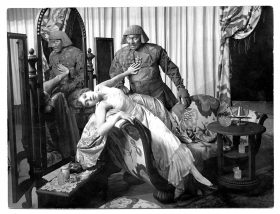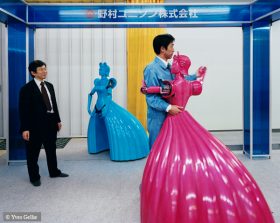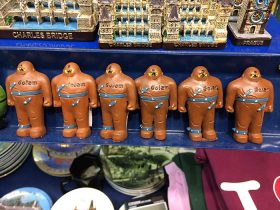
In the light comedy The Golem and the Dancing Girl from 1917, Paul Wegener satirizes his own 1915 film The Golem; photo: Deutsches Filminstitut, Frankfurt a. M./estate Paul Wegener – collection Kai Möller
In January of 1915 the figure of a golem appeared for the first time on the silver screen, on Berlin’s Kurfürstendamm. The public was captivated by a truly modern monster. At the same time, southeast of the Belgian city of Ypres battles of the First World War were raging. Following on the heels of this first silent golem movie came two more in 1917 and 1920, also debuting in Berlin. The lead role of the golem was played in all of them by Paul Wegener, who had also come up with the idea for the projects and written the screenplays.
In the current exhibition GOLEM (more on www.jmberlin.de/en/golem), a theme room has been dedicated to these three silent movies. → continue reading
The golem, a character from Jewish mythology, is currently present in an interesting exhibition at the Jewish Museum Berlin. But not only there.

Yves Gellie, Human Version 2.08, Dancing Robot, Tohoku University, Japan; photo: Yves Gellie, galerie du jour agnès b
Guest article by Roberto Giardina, www.ildeutschitalia.com
In the foyer of the Museum for Communication, three robots – reminiscent of chess figures – are roaming around. They talk to the people walking up to them, stop and take a different route if you block their way, or accompany you when you walk next to them. Adults are just as fascinated as children. A visit to Berlin museums is fun, and doesn’t necessarily require you to speak German.
After playing on the ground floor at the Museum for Communication, you can visit the special exhibition on the Golden Section and have your forgotten school knowledge entertainingly refreshed (the exhibition Göttlich Golden Genial (godly golden genius) runs until 26 February, more on the Museum for Communication website (in German)).
Robots are fun to play with, but they have been the stuff of nightmares since time immemorial – will they take our jobs away from us soon? → continue reading

Souvenir shop in Prague, 2016; photo: Katharina Schmidt-Narischkin
They’re ubiquitous in Prague souvenir shops: clunky, mechanical golem figurines that owe their popularity to the 1951 film The Emperor and the Golem. The Czechoslovakian comedy classic, called Císařův pekař a pekařův císař in the original, was conceived by Martin Frič and Jiří Krejčík as a comedy of errors with political undertones. An irascible Emperor Rudolph II and his corrupt court are searching alternately for an elixir of youth and a recipe to turn lead into gold. But above all they want to find the legendary golem. This is the missing piece in the emperor’s cabinet of wonders and curiosities. On the search for the golem a brilliant switch takes place between Rudolf and his imperial baker, Matej. It’s an exchange from which both can profit in their different ways: → continue reading


